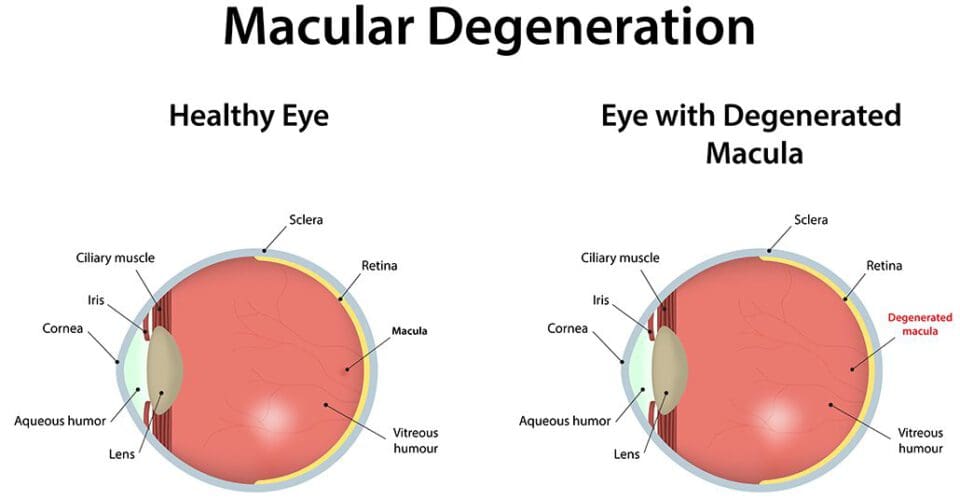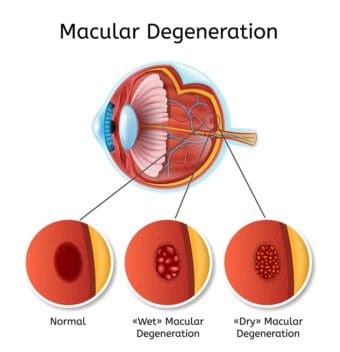Last Updated
Further Reading
- Exophthalmos
- Distorted Vision
- Chronic Uveitis
- Peripheral Vision Loss
- High Eye Pressure
- Eyelash Mites
- Shingles
- Eye Herpes
- Anisometropia
- Keratitis
- Eye Dilation
- Eye Infection Symptoms
- Eye Worms
- Macular Pucker
- Exotropia (Eye Misalignment)
- Do Eyelashes Grow Back
- Cyclopia
- Neosporin for the Eyes
- How Multiple Sclerosis Affects Your Eyes
- Ocular Myasthenia Gravis
- Horner’s Syndrome
- Cancer’s Effects on the Eyes
- States With the Worst Allergies
- How to Treat Swollen Eyes in Toddlers
- Retinal Disease Testing
- Central Retinal Vein Occlusion
- Scotoma (Blind Spot or Aura in Vision): Causes, Risk Factors and Treatment
- Convergence Insufficiency: What Is It, Symptoms and Treatments
- Squamous Cell Carcinoma of the Eyelid
- How HIV Affects the Eyes
- Corneal Arcus
- Emmetropia & Ametropia
- Chemosis Eye Irritation
- Cellulitis of the Eye
- Retinal Tears
- Rise in Myopia in Children During COVID-19
- Computer Vision Syndrome
- Conjunctivitis
- Blepharitis
- Chalazion
- Eye Discharge
- Fuchs' Dystrophy
- Pinguecula
- Scratched Cornea
- Subconjunctival Hemorrhage
- Uveitis
- Lazy Eye
- Nystagmus
- Ptosis
- Low Vision
- Eye PVD
- Retinal Detachment
- Tunnel Vision
- Diplopia
- Hyphema
- Styes
- Higher Order Aberrations of the Eye
- Coloboma
- Anisocoria
Stargardt Disease Guide (Cures & Treatment in 2022)
Home / Eye Conditions & Eye Diseases /
Last Updated
Table of Contents
There are no proven treatments for Stargardt disease. Theories are being tested, and doctors tell people to wear sunglasses, but as of now, this is all that can be done.
This is a genetic condition that is a form of macular degeneration. Because of this, some doctors may discuss macular degeneration treatments with their patients.
The first step is to get an accurate diagnosis of this condition. The symptoms can start between ages 10 and 40, so some people will not know that they have this condition until later in life.
Once there is an accurate diagnosis, people can talk to their doctors about the investigative treatment options. In some cases, traditional macular degeneration management options may also be discussed.
What Is Stargardt Disease?
Stargardt disease is the most commonly inherited form of macular degeneration, one that affects both eyes. It develops within a three-decade span, between ages 10 and 40, and symptoms include trouble reading, color perception changes and blind spots in the central vision.
Peripheral vision is usually not affected. However, Stargardt disease is progressive, meaning it get worse over time.
Causes of Stargardt Disease
Scientists point to Gene ABCA4 as the primary cause culprit. ABCA4 takes substances that are potentially toxic out of the photoreceptor cells. A mutated gene causes an inefficient removal of the substances, and the result is an accumulation of them.
This fatty, yellow pigment accumulates in the cells of the macula, and this buildup causes vision issues. Known as lipofuscin, the pigment remains after the absorption and breakdown of damaged blood cells. Eventually, cell death results, leading to progressive vision loss.
Gene ABCA4 is a recessive trait. This means that children have a 25 percent chance of developing the disease if both parents have the ABCA4 gene mutation.
ELOVL4 gene mutations also may cause this condition, although it is rare. Both the ELOVL4 and ABCA4 genes provide the information necessary for the creation of proteins that are present in the retina’s light-sensing cells.
EVOVL4 helps with creating long-chain fatty acids. It is mostly active in the retina, but also in the skin and brain. However, when this gene is mutated, EVOVL4 protein clumps form. As they accumulate, this can interfere with the function of retinal cells, ultimately resulting in the death of these cells.
What Is Macular Degeneration?
This condition affects more than 10 million people in the U.S., and it is the leading cause of vision loss in the country. Like Stargardt disease, macular degeneration is incurable.
When the central area of the retina deteriorates, this condition develops. This area is referred to as the macula.

The macula is responsible for being able to focus the eye’s central vision. When problems are occurring, it can affect a person’s ability to read, recognize colors or faces, drive a car, or observe details of an object.
Diagnosing Stargardt Disease
Initially, doctors may suspect more common forms of macular degeneration and perform the diagnostic tests used for this eye condition. These tests may include:
- Back-of-eye examination to look for drusen and the mottled appearance it causes.
- Indocyanine green angiography to determine the exact type of macular degeneration a person has.
- Amsler grid testing to determine central vision abilities.
- Optical coherence tomography to get a better look at the retina.
Once the doctor suspects Stargardt disease, they will dilate the eyes and perform an examination. They are looking at the retina to see if there are elongated white, branching flecks present. If they are observed, the doctor will confirm the diagnosis using fluorescein angiography.
Fluorescein angiography involves injecting a fluorescent dye to highlight the blood vessels. For this specific test, the doctor is observing those at the back of the eye and taking photos. Photos are taken before and after the dye is injected for comparison.
Stargardt Disease Treatment
There is no cure or treatment for Stargardt Disease. Doctors often recommend that people with the condition wear sunglasses in the sun and areas where the light is bright. While it has not been proven as helpful through research or clinical trials, doctors do believe sunglasses offer protective benefits.
In some cases, doctor may inject anti-VEGF drugs intraocularly as a treatment. They usually prescribe these medications most for wet macular degeneration.
Vascular endothelial growth factor (VEGF) is a protein that is naturally occurring in the body. It works to support organ and tissue growth by triggering new blood vessel formation. However, with wet macular degeneration and certain other diseases, it can cause the formation of abnormal blood vessels. This can result in loss of central vision and scarring when the vessels develop in the eyes.
These medications work to inhibit the activation and binding of VEGF receptors. Getting shots regularly may stop the formation of these abnormal blood vessels. Following anesthetic eye drops, doctors inject the medicine directly into affected eyes.
European doctors are exploring gene therapy as a possible treatment. One promising therapy introduces a virus that triggers formation of ABCR protein. The theory is that this protein will replace the defective one.
Stem cells are another area of hope. A recent study by two American doctors showed that patients showed improved or stabilized vision for the majority of people who received autologous bone marrow-derived stem cells treatments. Of the 17 patients who were treated, 76.5 percent (13 of them) showed improved vision and 17.6 percent (three patients) showed no visual decline.
Macular Degeneration Treatments
The actual medical treatments used for macular degeneration are not used for Stargardt disease. However, some of the management techniques may be considered.
The following are lifestyle methods that may be helpful for some people:

- Do not smoke.
- Make sure any other medical conditions are under control.
- Have eye exams routinely, according to a schedule created by a doctor.
- Exercise regularly.
Certain vitamins may benefit people with vision loss. These vitamins are sometimes recommended to people who have the early stage of dry macular degeneration.
- Vitamin C 500 mg
- Lutein 10 mg
- Zinc 80 mg
- Vitamin E 400 IU
- Zeaxanthin 2 mg
- Copper 2 mg
Never take any supplements without the consent of a doctor. It is possible for supplements to do more harm than good, especially when someone is using them incorrectly.
While there are no treatments, research is being performed to look for potential options for the future. Currently, wearing sunglasses and following other management options used for macular degeneration can be beneficial for some people.
References
- Stargardt Disease. Bright Focus Foundation.
- Stargardt Disease Defined. American Macular Degeneration Foundation.
- Stargardt Disease. Genetic and Rare Diseases Information Center.
- Lipofuscin. MedlinePlus.
- What Is Macular Degeneration? American Macular Degeneration Foundation.
- Fluorescein Angiography. Healthline.
- Dry Macular Degeneration. Mayo Clinic.
- Eylea Injection Treatment of Macular Degeneration. American Macular Degeneration Foundation.
- EU/3/08/609. European Medicines Agency.
- Stem Cell Ophthalmology Treatment Study (SCOTS): Bone Marrow-Derived Stem Cells in the Treatment of Stargardt Disease. (February 2021). Medicines.
The information provided on this page should not be used in place of information provided by a doctor or specialist. To learn more, read our Privacy Policy and Editorial Policy pages.
Further Reading
- Exophthalmos
- Distorted Vision
- Chronic Uveitis
- Peripheral Vision Loss
- High Eye Pressure
- Eyelash Mites
- Shingles
- Eye Herpes
- Anisometropia
- Keratitis
- Eye Dilation
- Eye Infection Symptoms
- Eye Worms
- Macular Pucker
- Exotropia (Eye Misalignment)
- Do Eyelashes Grow Back
- Cyclopia
- Neosporin for the Eyes
- How Multiple Sclerosis Affects Your Eyes
- Ocular Myasthenia Gravis
- Horner’s Syndrome
- Cancer’s Effects on the Eyes
- States With the Worst Allergies
- How to Treat Swollen Eyes in Toddlers
- Retinal Disease Testing
- Central Retinal Vein Occlusion
- Scotoma (Blind Spot or Aura in Vision): Causes, Risk Factors and Treatment
- Convergence Insufficiency: What Is It, Symptoms and Treatments
- Squamous Cell Carcinoma of the Eyelid
- How HIV Affects the Eyes
- Corneal Arcus
- Emmetropia & Ametropia
- Chemosis Eye Irritation
- Cellulitis of the Eye
- Retinal Tears
- Rise in Myopia in Children During COVID-19
- Computer Vision Syndrome
- Conjunctivitis
- Blepharitis
- Chalazion
- Eye Discharge
- Fuchs' Dystrophy
- Pinguecula
- Scratched Cornea
- Subconjunctival Hemorrhage
- Uveitis
- Lazy Eye
- Nystagmus
- Ptosis
- Low Vision
- Eye PVD
- Retinal Detachment
- Tunnel Vision
- Diplopia
- Hyphema
- Styes
- Higher Order Aberrations of the Eye
- Coloboma
- Anisocoria